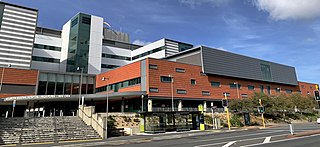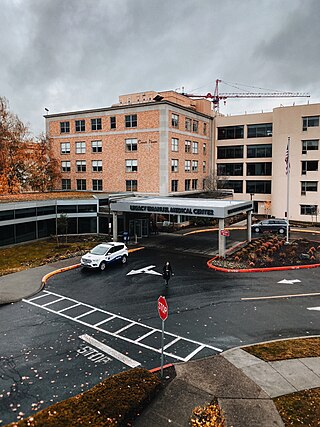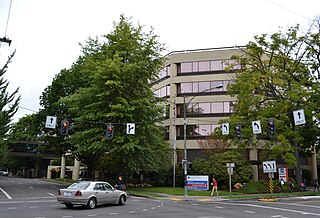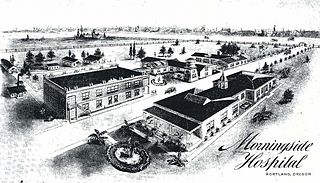
Sydney Adventist Hospital, commonly known as the San, is a large private hospital in Sydney, Australia, located on Fox Valley Road in Wahroonga. Established on 1 January 1903, as a not-for-profit organisation, it was originally named the Sydney Sanitarium from which its colloquial name was derived. The hospital is operated by the Seventh-day Adventist Church, whose South Pacific Division headquarters are located in the immediate vicinity of the San. The hospital offers a broad range of acute medical, surgical, diagnostic, outpatient, support and wellness services, including Executive Health Checks at the Fox Valley Medical & Dental Centre.
Penang Adventist Hospital is a non-profit hospital in George Town within the Malaysian state of Penang. Established in 1924, the 200-bed medical institution is part of an international network of hospitals operated by the Seventh-day Adventist Church. The hospital is well known in the community for its promotion of a healthy vegetarian diet and charity work to assist needy patients, particularly heart patients.

Providence Portland Medical Center, located at 4805 NE Glisan St. in the North Tabor neighborhood of Portland, Oregon, is a full-service medical center specializing in cancer and cardiac care. Opened in 1941, the hospital is licensed for 483 beds, and has over 3,000 employees. There are approximately 1,000 physicians on staff. The campus is also home to Providence Child Center, a 58-bed facility dedicated exclusively to medically fragile children. Providence Portland Medical Center is part of the Providence Health & Services in Oregon. Providence Portland Medical Center is one of four nursing magnet hospitals in Oregon, the others being Providence St. Vincent Medical Center, Veterans Affairs hospital, and OHSU Hospital in Portland.

Adventist HealthCare Shady Grove Medical Center is a 266-licensed bed acute care facility located in Rockville, Maryland. Shady Grove Medical Center provides a range of health services to the community such as high-risk obstetrical care, cardiac and vascular care, oncology services, orthopedic care, surgical services and pediatric care. Opened in 1979 as Shady Grove Adventist Hospital, Shady Grove Medical Center operates as part of Adventist HealthCare, a health-care delivery system that includes hospitals, home health agencies and other health-care services. Adventist HealthCare is headquartered in Gaithersburg, Maryland.

Wellington Hospital, also known as Wellington Regional Hospital, is the main hospital in Wellington, New Zealand, located south of the city centre in the suburb of Newtown. It is the main hospital run by Te Whatu Ora, Capital, Coast and Hutt Valley.

Tallahassee Memorial HealthCare (TMH) is a private, not-for-profit community healthcare system founded in 1948. Located in Tallahassee, Florida, United States and serving a 22-county region in North Florida and South Georgia, TMH comprises a 772-bed acute care hospital, a psychiatric hospital, multiple specialty care centers, five residency programs, 50 affiliated physician practices, and partnerships with Alliant Management Services, Apalachee Center, Calhoun Liberty Hospital, Capital Health Plan, Doctors’ Memorial Hospital, Florida State University, Big Bend Hospice and Radiology Associates.

Hillsboro Medical Center, formerly Tuality Community Hospital, is a medical care facility located in Hillsboro in the U.S. state of Oregon. The 167-bed facility was founded in 1918 in downtown and is one of two hospitals in Hillsboro, Washington County's most populous city. Since 2019, it has been operated by OHSU Health, and previously had partnerships with Oregon Health & Science University and Pacific University. At six stories tall, the main building was tied for the tallest in the city with the Hillsboro Civic Center as of 2006.

Legacy Emanuel Medical Center is a hospital located in the Eliot neighborhood of Portland, Oregon, United States. Founded in 1912, it is one of only two Level I trauma centers in the state of Oregon, and home to the only burn center between Seattle and Sacramento. The hospital is also home to the Life Flight Network (MEDEVAC), the first of its kind instituted on the U.S. West Coast. The 554-bed facility provides a full range of services, including conventional surgery, heart treatment, critical care, neurology/stroke care/brain surgery, and care for high-risk pregnancies. Legacy Emanuel also houses the Randall Children's Hospital. It is one of the hospitals in the area where gun shot victims are routinely brought in.

Adventist Health Columbia Gorge is a hospital complex in The Dalles, Oregon, United States.

MelroseWakefield Hospital is a 174-bed non-profit hospital located in Melrose, Massachusetts. MelroseWakefield Hospital and Lawrence Memorial Hospital of Medford function as one hospital entity with two campus locations. The MelroseWakefield Hospital campus provides many different areas of inpatient patient care including general surgery, interventional cardiovascular services, gynecology, maternity, special care nursery, orthopedics, and urology. It also offers outpatient care such as same day surgery, endoscopy, imaging and emergency services as well as serving as the region's Level III Trauma Center.

Mater Health Services North Queensland operates two private hospitals, one established by the Sisters of Mercy in 1945 named Mater Hospital Pimlico and the second purchased in 2007 named the Mater Women's and Children's Hospital Hyde Park.

PeaceHealth Sacred Heart Medical Center University District is a former hospital in Eugene, Oregon, United States. Originally called Sacred Heart Medical Center, the newer name reflected its location near the University of Oregon and Northwest Christian University. It was one of two Sacred Heart facilities in the Eugene-Springfield area owned by PeaceHealth. The other facility, Sacred Heart Medical Center at RiverBend, is in Springfield and is still open.

Providence Willamette Falls Medical Center is a not-for-profit acute care hospital operated by Providence Health & Services in Oregon City, Oregon, United States. Established in 1954 as Doctors' Hospital, the hospital moved to its current location in 1961 and has 143 licensed beds at its 243,000-square-foot (22,600 m2) facility. Willamette Falls also operates several medical offices and clinics outside of Oregon City in other parts of Clackamas County. Previously known as Willamette Falls Hospital, the hospital merged with Providence in 2009.
Adventist Health Feather River, also known as Feather River Hospital, was a 101-bed acute care hospital located in the town of Paradise, in Butte County, California, with a wide array of outpatient departments and services designed to meet the health care needs of Paradise, Magalia, and neighboring communities. It was severely damaged in the November 2018 Camp Fire and is currently closed.
Walla Walla General Hospital was a 72-bed acute-care hospital located at the base of the Blue Mountains and served approximately 70,000 residents of Southeastern Washington and Northeastern Oregon. It closed in July 2017.

Morningside Hospital was a psychiatric hospital in Portland, Oregon, United States. The hospital was contracted to provide care for people committed to psychiatric hospitals from Alaska from 1904 to 1960.

Legacy Mount Hood Medical Center is a hospital in Gresham in the U.S. state of Oregon. Established in 1959, the 115-bed facility in the Portland metropolitan area is owned by the nonprofit Legacy Health. Originally a for-profit hospital, it moved to its current campus in 1984.
Fuller Hospital is a 109-bed behavioral health hospital located in South Attleboro, Massachusetts. The hospital is owned by Universal Health Services.

The Portland Sanitarium Nurses' Quarters, located at 6012 Southeast Yamhill Street in southeast Portland, Oregon, are listed on the National Register of Historic Places. The back portion of the building, constructed in 1928, features a neoclassical brick style while the four-story front portion was built in 1946 in an International style. It was designed by Claussen and Claussen.

















